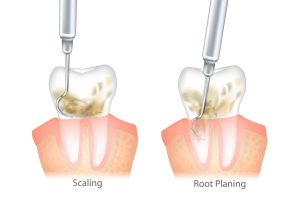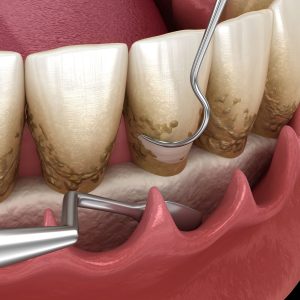Reclaim Your Gum Health: A Deep Dive into Scaling and Root Planing
Are you battling gum disease and looking to improve your gum health? At the West Sayville, NY dental practice of Dr. Sigismondi, we understand the importance of taking a patient-centered approach to oral health. One of the most effective treatments we offer is scaling and root planing, a deep cleaning procedure that helps combat gum disease and promote a healthier smile. If you’re experiencing signs of gum inflammation or have been diagnosed with periodontal disease, this comprehensive guide will provide you with valuable insights into the benefits, process, and what to expect from this life-changing treatment. Learn more by contacting our Long Island dental practice at 631-563-1583.
What is Scaling and Root Planing?
Scaling and root planing, also called dental deep cleaning or dental scaling and root planing, is a procedure used to treat gum disease that goes beyond regular dental cleaning. Dental scaling and planing involves removing plaque and tartar buildup from the surfaces of the teeth, both above and below the gum line. Additionally, the root surfaces are carefully smoothed out, eliminating any rough spots where bacteria and plaque can accumulate. Dental scaling and root planing helps to eliminate the harmful symptoms often present after chronic periodontal disease occurs and creates a clean environment for the gums to heal and reattach to the teeth.
Benefits of Scaling and Root Planing
- Reduces Inflammation and Swelling in the Gums: Scaling and root planing remove plaque and tartar buildup, the primary culprits behind gum inflammation (gingivitis) and its more advanced stage, periodontitis. By eliminating these irritants, the procedure allows the inflamed gums to heal, reducing redness, swelling, and discomfort.
- Stops the Progression of Gum Disease: Left untreated, gum inflammation can worsen, leading to the destruction of supporting bone and tissue around the teeth, ultimately causing tooth loss. Scaling and root planing effectively halt this progression by removing harmful bacteria and creating a clean surface for healthy gum tissue to reattach.
- Promotes the Reattachment of Gums to Teeth: During gum disease, the gum tissue pulls away from the teeth, forming pockets. Root planing and dental scaling remove bacteria and toxins within these pockets, allowing the gums to shrink and reattach firmly to the tooth surface. This reattachment creates a barrier against further infection and promotes long-term gum health.
- Improves Gum Health: By addressing the root cause of gum disease, scaling, and root planing promote gum health. This includes healthier gum tissue color, reduced bleeding during brushing and flossing, and a decrease in gum sensitivity. It also helps prevent the need for periodontal surgery, such as gum grafting and laser treatment.
- Prevents Tooth Loss: Gum disease is a leading cause of tooth loss in adults. By effectively treating and preventing gum disease progression, scaling, and root planing help preserve your natural teeth and maintain a healthy, functional smile.
- Freshens Breath: Bad breath (halitosis) is often a symptom of gum disease due to the presence of bacteria and decaying food particles. Scaling and root planing eliminates these sources of bad breath, leaving your breath feeling fresh and clean.
- Enhances the Aesthetic Appearance of the Smile: Healthy gums are not only essential for oral health but also contribute to a beautiful smile. Scaling and root planing reduce gum inflammation and swelling, revealing a healthier and more aesthetically pleasing gum line. Additionally, removing surface stains caused by plaque and tartar can brighten your smile, enhancing its appearance.
Who Qualifies for Scaling and Root
Planing?
Scaling and root planing are typically recommended for patients who have been diagnosed with gingivitis (early-stage gum disease) or periodontitis (advanced gum disease). Dr. Sigismondi may also suggest this treatment for individuals with significant plaque and tartar buildup, even if they don’t display obvious signs of gum disease. It’s essential to seek professional dental care in West Sayville, NY, to determine if deep cleaning treatment is the appropriate course of action.
The Scaling and Root Planing Process
Consultation
Before undergoing periodontal scaling and root planing, Dr. Sigismondi will conduct a thorough examination of your mouth, including taking X-rays and measuring the depth of any periodontal pockets (spaces between the teeth and gums). This evaluation helps determine the extent of the gum disease and the best treatment plan.
Preparation
To ensure your comfort during the procedure, Dr. Sigismondi may administer a local anesthetic to numb the area being treated. Additionally, antimicrobial rinses or gels may be applied to reduce the bacterial load in the mouth.
Scaling and Root Planing
During the tooth scaling and root planing procedure, Dr. Sigismondi uses specialized dental instruments to carefully remove plaque, tartar, and calcified deposits from the tooth surfaces and root areas. The root surfaces are then smoothed out to prevent future buildup. Depending on the extent of the gum disease, the treatment may be divided into multiple visits to allow for proper healing.
Scaling and Root Planing Aftercare
- Practice good oral hygiene. Brush and floss gently but thoroughly twice a day to keep the areas free of plaque and food debris.
- Use an antimicrobial mouthwash. Dr. Sigismondi may recommend using chlorhexidine or other antimicrobial mouthwash to help control bacteria and promote healing.
- Take over-the-counter pain medication as needed. You may experience some discomfort or sensitivity for a few days after the procedure. Take ibuprofen or acetaminophen as directed to manage pain.
- Avoid certain foods and drinks. Steer clear of very hot, spicy, crunchy, or acidic foods and beverages that could irritate your gums while they are healing.
- Don’t smoke or use tobacco products. Smoking can impair the healing process and increase your risk of complications.
- Apply a cold compress. If you experience swelling, apply a cold compress to the outside of your cheek for 10-15 minutes several times a day.
- Attend follow-up appointments. Dr. Sigismondi will want to check on the healing progress and may need to perform additional treatments or maintenance cleanings.
- Consider using a desensitizing toothpaste. If you experience tooth sensitivity after the procedure, using a desensitizing toothpaste can help minimize discomfort.
- Be gentle when brushing and flossing. Avoid vigorous brushing or flossing during the first week to prevent irritation or bleeding.
- Follow any additional instructions from your dentist. Dr. Sigismondi may provide specific aftercare guidelines based on your case.
Frequently Asked Questions
While some discomfort may be experienced during and after the procedure, your dentist will take steps to minimize any pain or discomfort. Local anesthesia is typically used, and over-the-counter pain medications can be taken afterward to manage any residual soreness. The temporary discomfort is worth the long-term benefits of improved gum health.
The duration of the procedure depends on the severity of the gum disease and the number of areas that need to be treated. In general, the process can take anywhere from one to several visits, with each appointment lasting between one and two hours.
The healing process varies from patient to patient, but most individuals experience significant improvement in gum health within a few weeks to a few months after the treatment. It’s essential to maintain good oral hygiene habits and attend follow-up appointments for optimal healing and long-term results.
Scaling and root planing is often covered by dental insurance, but the extent of coverage can vary depending on your specific plan. Generally, it’s considered a medically necessary treatment for gum disease, increasing the likelihood of insurance coverage. However, factors like the number of teeth requiring treatment, the severity of gum disease, and your annual coverage limits can influence the amount covered.
To understand your specific situation, it’s crucial to contact your dental insurance provider directly or review your policy documents. They can provide details about your coverage for teeth scaling and root planing, allowing you to plan for any potential out-of-pocket costs.





